Ecological Zoning of the Baikal Basin Based on the Results of Chemical Analysis of the Composition of Atmospheric Precipitation Accumulated in the Snow Cover
Abstract
1. Introduction
2. Sampling and Analysis Methods
2.1. Field Sampling
2.2. Location of Districts
2.3. Meteorological Parameters
2.4. Geostatistical Analysis Method
2.5. Calculation of the Values of Accumulation in Snow Cover
3. Results and Discussion
3.1. Concentration of the Main Ions in the Snow Waters of the Baikal Basin
3.2. Spatial Distribution of Atmospheric Impurities in the Snow Cover of the Baikal Basin
4. Conclusions
Author Contributions
Funding
Institutional Review Board Statement
Informed Consent Statement
Data Availability Statement
Acknowledgments
Conflicts of Interest
References
- Viklander, M. Urban snow deposits—Pathways of pollutants. Sci. Total Environ. 1996, 189, 379–384. [Google Scholar] [CrossRef]
- Murozumi, M.; Chow, T.J.; Patterson, C. Chemical concentrations of pollutant lead aerosols, terrestrial dusts and sea salts in Greenland and Antarctic snow strata. Geochim. Cosmochim. Acta 1969, 33, 1247–1294. [Google Scholar] [CrossRef]
- Bezuglaya, E.Y. Monitoring of the State of Air Pollution in Cities; Gidrometeoizdat: Leningrad, Russia, 1986; p. 200. [Google Scholar]
- Vasilenko, V.N.; Nazarov, I.M.; Fridman, S.D. Snow Cover Pollution Monitoring; Gidrometeoizdat: Leningrad, Russia, 1985; p. 182. [Google Scholar]
- Obolkin, V.A.; Potemkin, V.L.; Makukhin, V.L.; Khodzher, T.V.; Chipanina, E.V. Long-range transport of plumes of atmospheric emissions from regional coal power plants to the South Baikal water basin. Atmos. Ocean. Opt. 2017, 30, 360–365. [Google Scholar] [CrossRef]
- Pershina, N.A.; Pavlova, M.T. Background component of atmospheric precipitation. Proc. Voeikov Main Geophys. Obs. 2013, 569, 224–232. [Google Scholar]
- Romanovskaya, A.Y.; Savin, I.Y. Aerosol dust of soil origin in the atmosphere: Sources, quantity, properties (review). Bull. V. V. Dokuchaev Soil Sci. Inst. 2021, 109, 36–95. [Google Scholar] [CrossRef]
- Tubiello, F.N.; Salvatore, M.; Rossi, S.; Ferrara, A.; Fitton, N.; Smith, P. The FAOSTAT database of greenhouse gas emissions from agriculture. Environ. Res. Lett. 2013, 8, 015009. [Google Scholar] [CrossRef]
- Stern, D.I. Reversal of the trend in global anthropogenic sulfur emissions. Glob. Environ. Chang. 2006, 16, 207–220. [Google Scholar] [CrossRef]
- Crippa, M.; Guizzardi, D.; Pisoni, E.; Solazzo, E.; Guion, A.; Muntean, M.; Hutfilter, A.F. Global anthropogenic emissions in urban areas: Patterns, trends, and challenges. Environ. Res. Lett. 2021, 16, 074033. [Google Scholar] [CrossRef]
- Reay, D.S.; Davidson, E.A.; Smith, K.A.; Smith, P.; Melillo, J.M.; Dentener, F.; Crutzen, P.J. Global agriculture and nitrous oxide emissions. Nat. Clim. Chang. 2012, 2, 410–416. [Google Scholar] [CrossRef]
- Viskari, E.-L.; Rekilä, R.; Roy, S.; Lehto, O.; Ruuskanen, J.; Kärenlampi, L. Airborne pollutants along a roadside: Assessment using snow analyses and moss bags. Environ. Pollut. 1997, 97, 153–160. [Google Scholar] [CrossRef]
- Kuchmenko, E.V.; Molozhnikova, E.V.; Marinaite, I.I.; Zarodnyuk, M.S. Identification of aerosol sources by the ratio of individual concentrations of anthropogenic pollutants. Opt. Atmos. Ocean. 2005, 18, 497–501. [Google Scholar]
- Balyshev, O.A.; Zarodnyuk, M.S.; Kuchmenko, E.V.; Chipanina, E.V. Evaluation of the contribution of heat sources to the pollution of the snow cover of industrial zones. Eng. Ecol. 2010, 1, 39–53. [Google Scholar]
- Koroleva, G.P.; Gorshkov, A.G.; Vinogradov, T.P.; Butakov, E.V.; Marinaite, I.I.; Khodzher, T.V. Study of snow cover pollution as a depositing medium. Chem. Sustain. Dev. 1998, 6, 227–237. [Google Scholar]
- Viklander, M. Substances in urban snow. A comparison of the contamination of snow in different parts of the city of Luleå, Sweden. Water Air Soil Pollut. 1999, 114, 377–394. [Google Scholar] [CrossRef]
- Raputa, V.F.; Talovskaya, A.V.; Kokovkin, V.V.; Yazikov, E.G. Analysis of observational data on aerosol pollution of the snow cover in the vicinity of Tomsk and Seversk. Opt. Atmos. Ocean. 2011, 24, 74–78. [Google Scholar]
- Naprasnikova, E.V.; Makarova, A.P. Snow cover in assessing the ecological state of the urban environment. Geogr. Nat. Resour. 2006, 3, 162–166. [Google Scholar]
- Pozhitkov, R.; Moskovchenko, D.; Soromotin, A.; Kudryavtsev, A.; Tomilova, E. Trace elements composition of surface snow in the polar zone of northwestern Siberia: The impact of urban and industrial emissions. Environ. Monit. Assess. 2020, 192, 215–230. [Google Scholar] [CrossRef]
- Popovicheva, O.; Chichaeva, M.; Kovach, R.; Zhdanova, E.; Kasimov, N. Seasonal, Weekly, and Diurnal Black Carbon in Moscow Megacity Background under Impact of Urban and Regional Sources. Atmosphere 2022, 13, 563. [Google Scholar] [CrossRef]
- Zhurba, O.M.; Alekseenko, A.N.; Shayakhmetov, S.F.; Merinov, A.V. Study of polycyclic aromatic and petroleum hydrocarbons in the snow cover in an urbanized area. Hyg. Sanit. 2019, 98, 1037–1042. [Google Scholar] [CrossRef]
- Raputa, V.; Kokovkin, V.V. Methods of Interpretation of the Data of Snow Cover Pollution Monitoring. Chem. Sustain. Dev. 2002, 10, 657–670. [Google Scholar]
- Bortnikova, S.B.; Raputa, V.F.; Devyatova, A.Y.; Yudakhin, F.N. Methods for analyzing snow cover pollution data in the zones of influence of industrial enterprises (on the example of Novosibirsk). Geoecol. Eng. Geol. Hydrogeol. Geocryol. 2009, 6, 515–525. [Google Scholar]
- Filimonenko, E.A. Ecological and Geochemical Situation in the Areas of Location of Thermal Power Facilities according to the Study of Insoluble and Soluble Phases of Snow (on the Example of the Tomsk Region). Master’s Thesis, National Research Tomsk Polytechnic University (TPU), Tomsk, Russia, 2015. [Google Scholar]
- Belozertseva, I.A. Environmental pollution monitoring in IrkAZ impact zone. Water Chem. Ecol. 2013, 10, 33–38. [Google Scholar]
- Zhulidov, A.V.; Robarts, R.D.; Pavlov, D.F.; Kämäri, T.J.; Gurtovaya, T.Y.; Meriläinen, J.J.; Pospelov, I.N. Long-term changes of heavy metal and sulphur concentrations in ecosystems of the Taymyr Peninsula (Russian Federation) North of the Norilsk Industrial Complex. Environ. Monit. Assess. 2011, 181, 539–553. [Google Scholar] [CrossRef]
- Telmer, K.; Bonham-Carter, G.F.; Kliza, D.A.; Hall, G.E. The atmospheric transport and deposition of smelter emissions: Evidence from the multi-element geochemistry of snow, Quebec, Canada. Geochim. Cosmochim. Acta 2004, 68, 2961–2980. [Google Scholar] [CrossRef]
- Karbalaei, S.; Hanachi, P.; Walker, T.R.; Cole, M. Occurrence, sources, human health impacts and mitigation of microplastic pollution. Environ. Sci. Pollut. Res. 2018, 25, 36046–36063. [Google Scholar] [CrossRef]
- Vetrov, V.A.; Kuzovkin, V.V.; Manzon, D.A. Precipitation acidity and fallout of nitrogen and sulfur on the territory of the Russian Federation from the data of monitoring the chemical composition of snow cover. Russ. Meteorol. Hydrol. 2015, 40, 667–674. [Google Scholar] [CrossRef]
- Khodzher, T.V. Study of the Composition of Atmospheric Precipitation and Their Impact on the Ecosystems of the Baikal Natural Territory. Master’s Thesis, Institute of Geography RAS, Moskow, Russia, 2005. [Google Scholar]
- Obolkin, V.A.; Netsvetaeva, O.G.; Golobokova, L.P.; Potemkin, V.L.; Zimnik, E.A.; Filippova, U.G.; Khodzher, T.V. Results of long-term studies of acid fallout in the South Baikal region. Geogr. Nat. Resour. 2013, 2, 66–73. [Google Scholar]
- Belozertseva, I.A.; Vorobieva, I.B.; Vlasova, N.V.; Gagarinova, O.V.; Yanchuk, M.S.; Lopatina, D.N. Ecological state of the coast of Lake Baikal and its impact on the pollution of the lake. Successes Mod. Nat. Sci. 2018, 11, 85–95. [Google Scholar]
- Nechaeva, E.G.; Makarov, S.A. Snow cover as an object of regional environmental monitoring. Geogr. Nat. Resour. 1996, 2, 43–48. [Google Scholar]
- Shevchenko, V.P.; Vorobyev, S.N.; Krickov, V.V.; Manasypov, R.M.; Politova, N.V.; Kopysov, S.G.; Pokrovsky, O.S. Trace elements in snow cover of western Siberia: Impact of snow deposition on surface water chemistry. In Biogeochemistry of Trace Elements; Nova Science Publishers, Inc.: New York, NY, USA, 2018; pp. 113–116. [Google Scholar]
- Walker, T.R.; Young, S.D.; Crittenden, P.D.; Zhang, H. Anthropogenic metal enrichment of snow and soil in north-eastern European Russia. Environ. Pollut. 2003, 121, 11–21. [Google Scholar] [CrossRef]
- Obolkin, V.; Khodzher, T.; Sorokovikova, L.; Tomberg, I.; Netsvetaeva, O.; Golobokova, L. Effect of long-range transport of sulphur and nitrogen oxides from large coal power plants on acidification of river waters in the Baikal region, East Siberia. Int. J. Environ. Stud. 2016, 73, 452–461. [Google Scholar] [CrossRef]
- Desinayak, N.; Prasad, A.K.; El-Askary, H.; Kafatos, M.; Asrar, G.R. Snow cover variability and trend over the Hindu Kush Himalayan region using MODIS and SRTM data. Ann. Geophys. 2022, 40, 67–82. [Google Scholar] [CrossRef]
- Colin, J.L.; Lim, B.; Herms, E.; Genet, F.; Drab, E.; Jaffrezo, J.L.; Davidson, C.I. Air-to-snow mineral transfer—Crustal elements in aerosols, fresh snow and snowpits on the Greenland Ice Sheet. Atmos. Environ. 1997, 31, 3395–3406. [Google Scholar] [CrossRef]
- Netsvetaeva, O.G.; Khodzher, T.V.; Golobokova, L.P.; Kobeleva, N.A.; Pogodaeva, T.V. The chemical composition of the snow cover in the reserves of the Baikal region. Geogr. Nat. Resour. 2004, 1, 66–72. [Google Scholar]
- Onishchuk, N.A.; Netsvetaeva, O.G.; Molozhnikova, E.V. Estimation of the influx of pollutants to the territory of the South Pribaykalye. Limnol. Freshw. Biol. 2020, 1, 374–381. [Google Scholar] [CrossRef]
- Onishchuk, N.A.; Netsvetaeva, O.G.; Molozhnikova, E.V. Investigation of the elemental composition of snow cover in industrial cities of the Irkutsk Region. Proc. SPIE 2020, 11560, 1156032. [Google Scholar] [CrossRef]
- Molozhnikova, Y.V.; Onishchuk, N.A.; Netsvetaeva, O.G.; Urdayeva, T.N. Analysis of the relationship between the environmental pollution and morbidity of the population of industrial cities in the southern Baikal region. Proc. SPIE 2020, 11560, 1156033. [Google Scholar] [CrossRef]
- Sorokovikova, L.M.; Netsvetaeva, O.G.; Tomberg, I.V.; Molozhnikova, Y.V. Monitoring of the snow cover chemical composition and its role in the acidification of the southern Baikal tributaries. Proc. SPIE 2020, 11560, 1156038. [Google Scholar] [CrossRef]
- Netsvetaeva, O.G.; Onischuk, N.A.; Marinaite, I.I.; Zhuchenko, N.A.; Khodzher, T.V. The chemical composition of the snow cover in specially protected, non-industrial and industrial areas of the Baikal region. In Proceedings of the XXVI International Symposium “Atmospheric and Ocean Optics, Physics of the Atmosphere”, Moscow, Russia, 6–10 June 2020. [Google Scholar]
- Onishchuk, N.A.; Shikhovtsev, M.Y.; Netsvetaeva, O.G.; Molozhnikova, Y.V. The total index of snow cover pollution in some industrial cities of the Southern Pribaikalye. Proc. SPIE 2021, 11916, 512–515. [Google Scholar] [CrossRef]
- Molozhnikova, Y.V.; Shikhovtsev, M.Y.; Marinaite, I.I.; Netsvetaeva, O.G.; Onishchuk, N.A. Spatial distribution of anthropogenic tracers in the snow cover of the Southern Baikal region. Proc. SPIE 2022, 12341, 450–455. [Google Scholar] [CrossRef]
- Molozhnikova, E.V.; Golobokova, L.P.; Marinaite, I.I.; Netsvetaeva, O.G.; Shikhovtsev, M.Y.; Khodzher, T.V. Chemical composition of atmospheric precipitation on the territory of the Baikal State Natural Biosphere Reserve (eastern coast of South Baikal). Meteorol. Hydrol. 2023, 4, 10–21. [Google Scholar]
- Grebenshchikova, V.I. Geochemical specificity of the composition of snow water in some cities of the Irkutsk region. Water Chem. Ecol. 2013, 2, 19–25. [Google Scholar]
- Belozertseva, I.A.; Vorobyova, I.B.; Vlasova, N.V.; Lopatina, D.N.; Yanchuk, M.S. Atmospheric pollution and fluorine content in snow in the lake waters Baikal. Mod. Probl. Sci. Educ. 2015, 2, 735. [Google Scholar]
- Belozertseva, I.A.; Vorobyova, I.B.; Vlasova, N.V.; Yanchuk, M.S.; Lopatina, D.N. Chemical composition of snow in the Lake Baikal water area and adjacent territory. Geogr. Nat. Resour. 2017, 1, 90–99. [Google Scholar] [CrossRef]
- Lisitskaya, L.G.; Shayakhmetov, S.F. The level of contamination of snow cover with fluoride compounds in the emission zone of aluminum production. Public Health Habit. 2021, 3, 41–46. [Google Scholar]
- Grebenshchikova, V.I.; Kuznetsov, P.V.; Efimova, N.V.; Khalbaev, V.L.; Kholodova, M.S. Ecological and geochemical assessment of the Irkutsk-Angara Industrial Zone. Geogr. Nat. Resour. 2017, 3, 56–66. [Google Scholar]
- Grebenshchikova, V.I.; Gritsko, P.P. Sources of uranium, thorium and sulfur in the snow water of the Irkutsk-Angarsk industrial Zone (Baikal region). Geosph. Res. 2020, 4, 58–67. [Google Scholar] [CrossRef]
- EMEP. EMEP Manual for Sampling and Chemical Analysis; Norwegian Institute for Air Research: Kjeller, Norway, 1995; 303p. [Google Scholar]
- Network Center for EANET. Technical Manual for Wet Deposition Monitoring in East Asia; Asia Center for Air Pollution Research: Niigata, Japan, 2010; 113p. [Google Scholar]
- Maksyutova, E.V. The snow cover regime of the Pre-Baikal region in a changing climate. Ice Snow 2017, 57, 221–230. [Google Scholar] [CrossRef]
- Naprasnikov, A.T.; Plyusnin, V.M. Patterns of snow cover distribution in the Baikal-Mongolian region. Geogr. Nat. Resour. 2015, 2, 171–176. [Google Scholar]
- Shikhovtsev, A.Y.; Kovadlo, P.G.; Lezhenin, A.A.; Kiselev, A.V.; Russkikh, I.V.; Kolobov, D.Y.; Shikhovtsev, M.Y. Influence of Atmospheric Flow Structure on Optical Turbulence Characteristics. Appl. Sci. 2023, 13, 1282. [Google Scholar] [CrossRef]
- Kovadlo, P.G.; Shikhovtsev, A.Y. Energy structure of optical atmospheric turbulence at various parameters of air flow. News Irkutsk. State Univ. Ser. Earth Sci. 2014, 8, 42–55. [Google Scholar]
- Semenov, M.Y.; Silaev, A.V.; Semenov, Y.M.; Begunova, L.A.; Semenov, Y.M. Identifying and Characterizing Critical Source Areas of Organic and Inorganic Pollutants in Urban Agglomeration in Lake Baikal Watershed. Sustainability 2022, 14, 14827. [Google Scholar] [CrossRef]
- Shikhovtsev, M.Y.; Onishchuk, N.A.; Netsvetaeva, O.G.; Molozhnikova, Y.V. Multivariate statistical analysis of the chemical composition of the snow in the industrial cities of the Southern Baikal region. Proc. SPIE 2021, 11916, 371–377. [Google Scholar] [CrossRef]
- Belozertseva, I.A.; Ubugunov, L.L.; Ubugunova, V.I.; Dorzhgotov, D.; Gininova, A.B.; Ubugunov, V.L.; Sorokova, A.A.; Badmaev, N.B. Soils of the Baikal region and adjacent territories. Successes Mod. Nat. Sci. 2018, 8, 96–105. [Google Scholar]
- Molozhnikov, V.N. Atlas: Baikal Region: Society and Nature; Paulsen: Moscow, Russia, 2021; 320p. [Google Scholar]
- Molozhnikov, V.N. Map: Natural Ecological Complexes and Vegetation of the Baikal Region; Sochava Institute of Geography: Irkutsk, Russia, 2020; 1p. [Google Scholar]
- Belov, A.V.; Vladimirov, I.N.; Sokolova, L.P. Cartographic assessment of the state of modern vegetation of the Pre-Baikal region for the optimization of nature management. Geogr. Nat. Resour. 2016, 2, 62–68. [Google Scholar]
- Ievskaya, A.A.; Korsunova, T.M.; Imeskenova, E.G. Analysis of the current state of vegetation in public gardens in the city of Ulan-Ude. Electron. Sci. Prod. J. AgroEcoInfo 2020, 2, 1–10. [Google Scholar]
- Saneev, B.G.; Ivanova, I.Y.; Maisyuk, E.P.; Tuguzova, T.F.; Ivanov, R.A. Energy infrastructure of the central ecological zone of the Baikal natural territory: Impact on the natural environment and ways to reduce it. Geogr. Nat. Resour. 2016, 5, 218–224. [Google Scholar]
- Eremina, I.D.; Vasil’chuk, J.Y. Temporal Variations in Chemical Composition of Snow Cover in Moscow. Geogr. Environ. Sustain. 2019, 12, 148–158. [Google Scholar] [CrossRef]
- Shumilova, M.; Saidulina, O.; Petrov, V. Study of snow cover contamination by example of Izhevsk. Vestn. Udmurt. Univ. 2012, 2, 83–89. [Google Scholar]
- Kondrat’ev, I.I.; Mukha, D.E.; Boldeskul, A.G.; Yurchenko, S.G.; Lutsenko, T.N. Chemical composition of precipitation and snow cover in the Primorsky krai. Russ. Meteorol. Hydrol. 2017, 42, 64–70. [Google Scholar] [CrossRef]
- Vasilevich, M.I.; Beznosikod, V.A.; Kondratenok, B.M. Chemical composition of snow cover in the taiga zone of the Komi Republic. Water Resour. 2011, 38, 530–542. [Google Scholar] [CrossRef]
- Yanchenko, N.I.; Baranov, A.N. Parameters of the distribution of fluorine, sulfur, and sodium in the Baikal region with the production of primary aluminum. Russ. J. Non-Ferr. Met. 2010, 51, 144–149. [Google Scholar] [CrossRef]
- Liu, H.; Shen, F.; Li, Q.; Wen, M.; Zhang, H.; Jiang, L.; Chai, L. Systematic control technologies for gaseous pollutants from non-ferrous metallurgy. J. Environ. Sci. 2023, 123, 65–82. [Google Scholar] [CrossRef]
- Yanchenko, N.I.; Sukhodolov, A.P.; Slutskii, S.L. Improving the Monitoring of the Snow Cover for Emission Components from Primary Aluminum Production. Metallurgist 2015, 59, 187–192. [Google Scholar] [CrossRef]
- Onuchin, A.; Kofman, G.; Zubareva, O.; Danilova, I. Using an Urban Snow Cover Composition-Based Cluster Analysis to Zone Krasnoyarsk Town (Russia) by Pollution Level. Pol. J. Environ. Stud. 2020, 29, 4257–4267. [Google Scholar] [CrossRef]
- Kolesar, K.R.; Mattson, C.N.; Peterson, P.K.; May, N.W.; Prendergast, R.K.; Pratt, K.A. Increases in wintertime PM2.5 sodium and chloride linked to snowfall and road salt application. Atmos. Environ. 2018, 177, 195–202. [Google Scholar] [CrossRef]
- Chebykin, E.P.; Dambinov, Y.A.; Khakhuraev, O.A.; Suturin, A.N. Sources of chemical elements entering the snow cover of the coastal zone of Listvyanka village (Lake Baikal). Geogr. Nat. Resour. 2018, 3, 74–85. [Google Scholar]
- Report No 2-TP (Air). Information on the Protection of Atmospheric Air. 2020. Available online: https://rpn.gov.ru/activity/reports-receiving/air/ (accessed on 29 January 2021).
- Galloway, J.N.; Likens, G.E.; Keene, W.C.; Miller, J.M. The composition of precipitation in remote areas of the world. J. Geophys. Res. Ocean. 1982, 87, 8771–8786. [Google Scholar] [CrossRef]
- Behera, S.N.; Sharma, M.; Aneja, V.P.; Balasubramanian, R. Ammonia in the atmosphere: A review on emission sources, atmospheric chemistry and deposition on terrestrial bodies. Environ. Sci. Pollut. Res. 2013, 20, 92–131. [Google Scholar] [CrossRef]
- Prasad Shukla, S.; Mukesh, S. Neutralization of rainwater acidity at Kanpur, India. Tellus B Chem. Phys. Meteorol. 2010, 62, 172–180. [Google Scholar] [CrossRef]
- Bauer, S.E.; Koch, D.; Unger, N.; Metzger, S.M.; Shindell, D.T.; Streets, D.G. Nitrate aerosols today and in 2030: A global simulation including aerosols and tropospheric ozone. Atmos. Chem. Phys. 2007, 7, 5043–5059. [Google Scholar] [CrossRef]
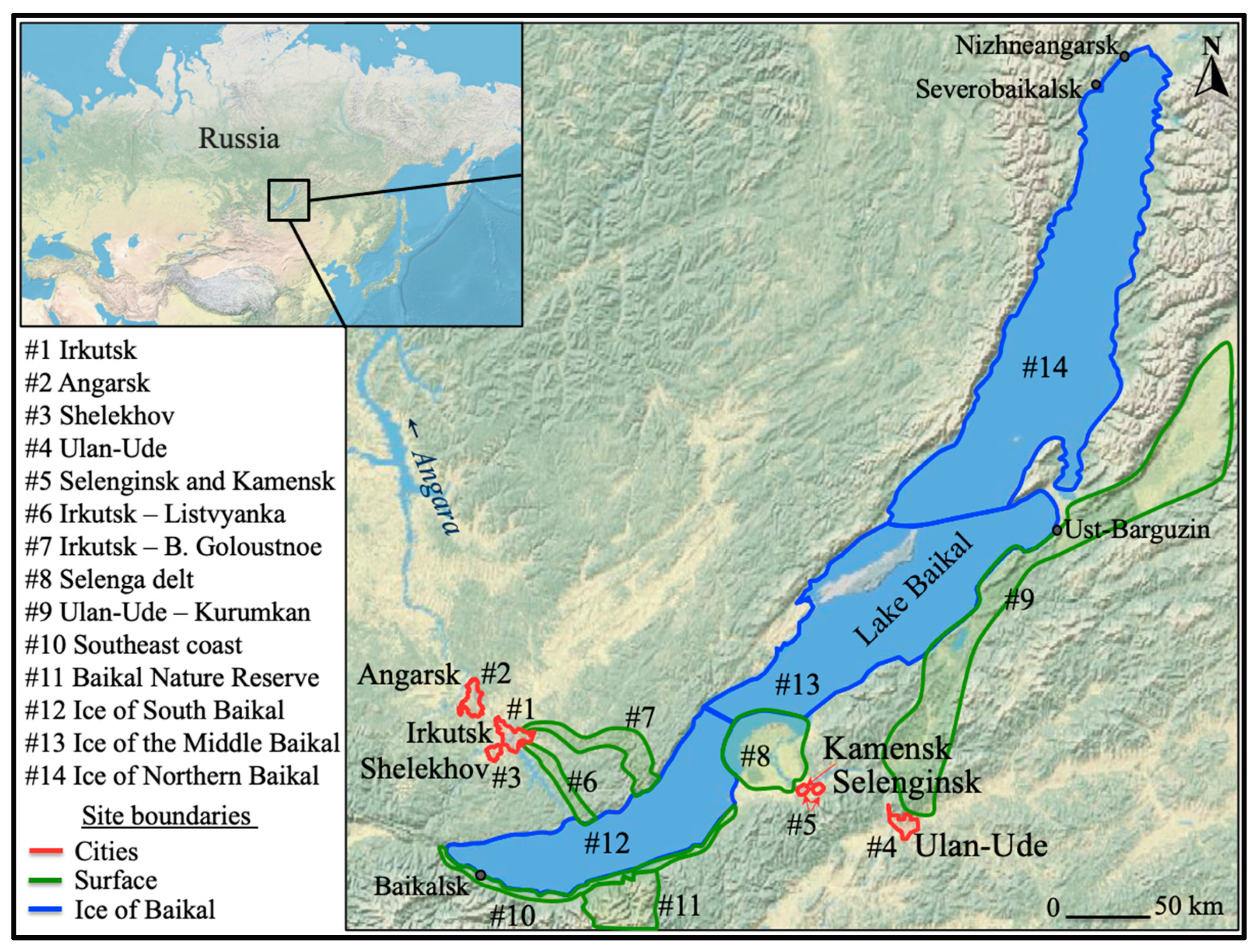
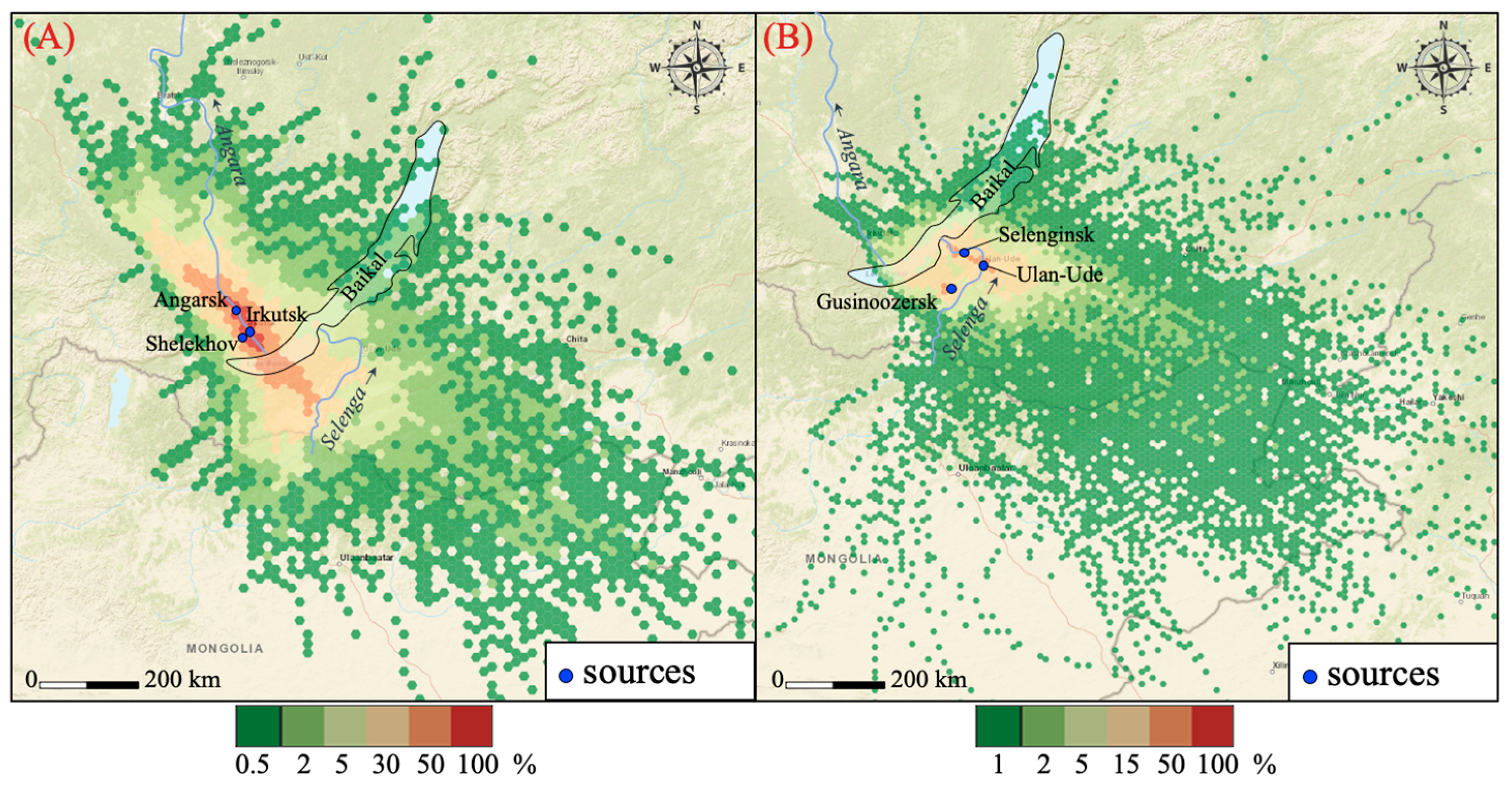
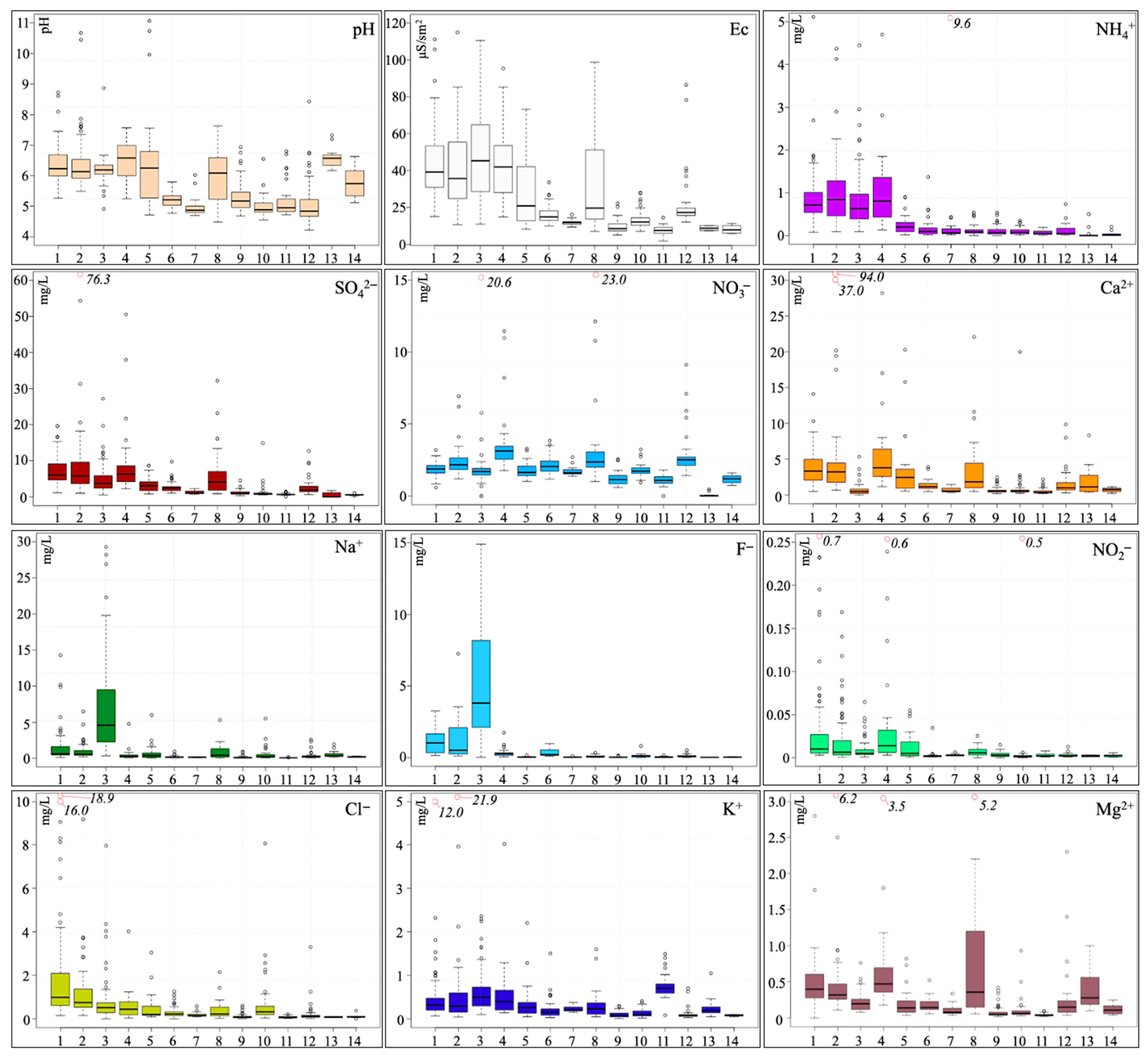
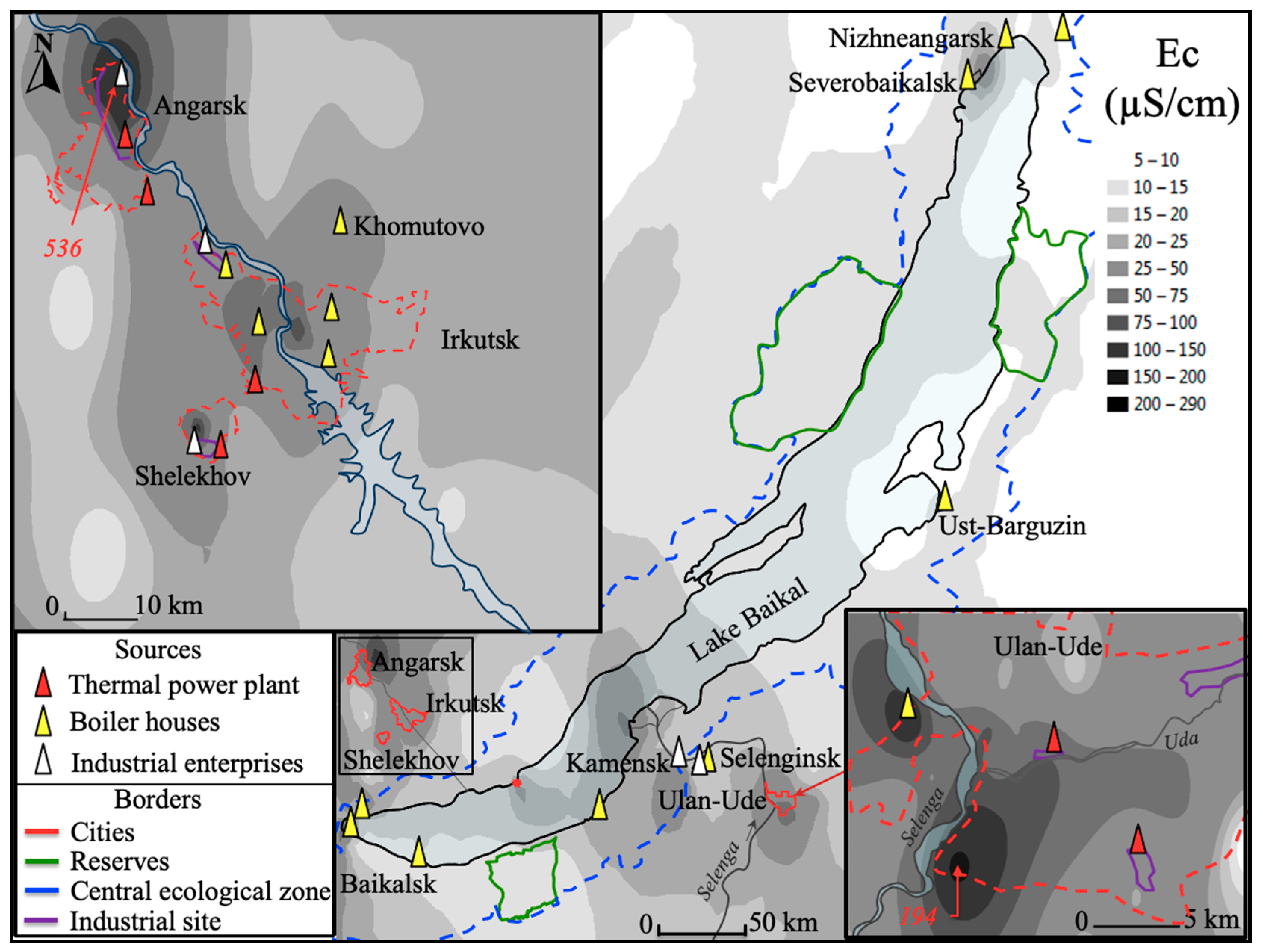
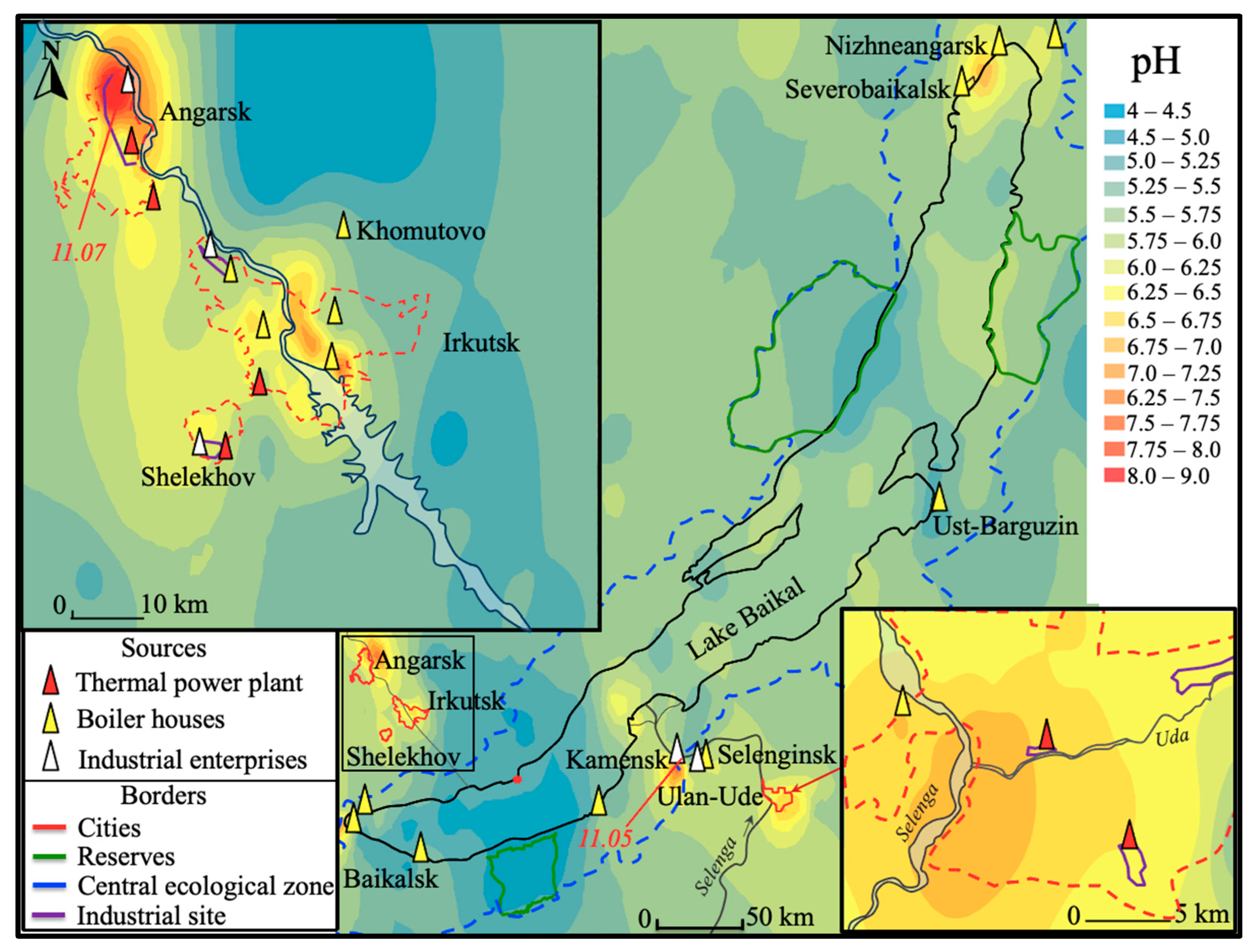
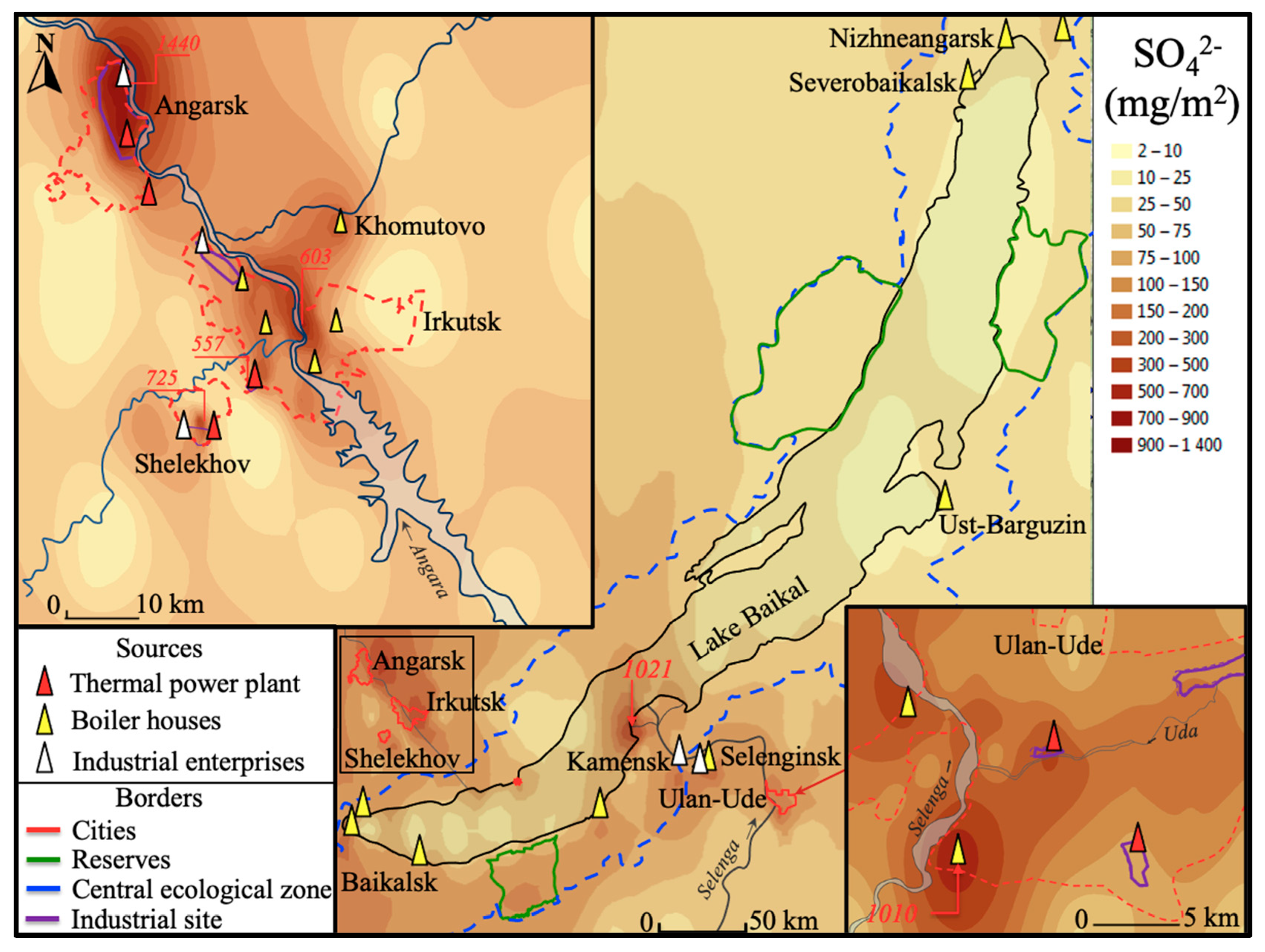
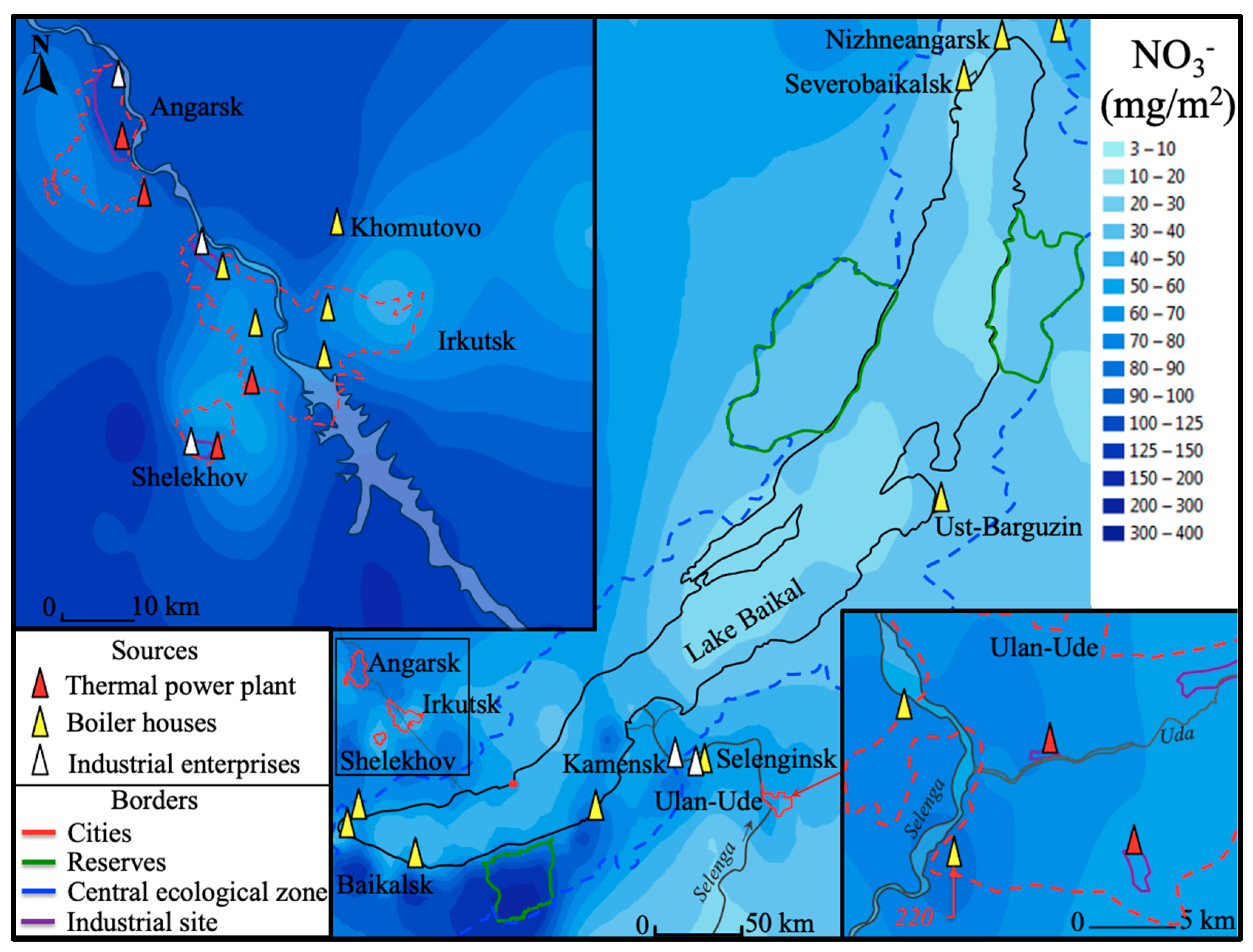
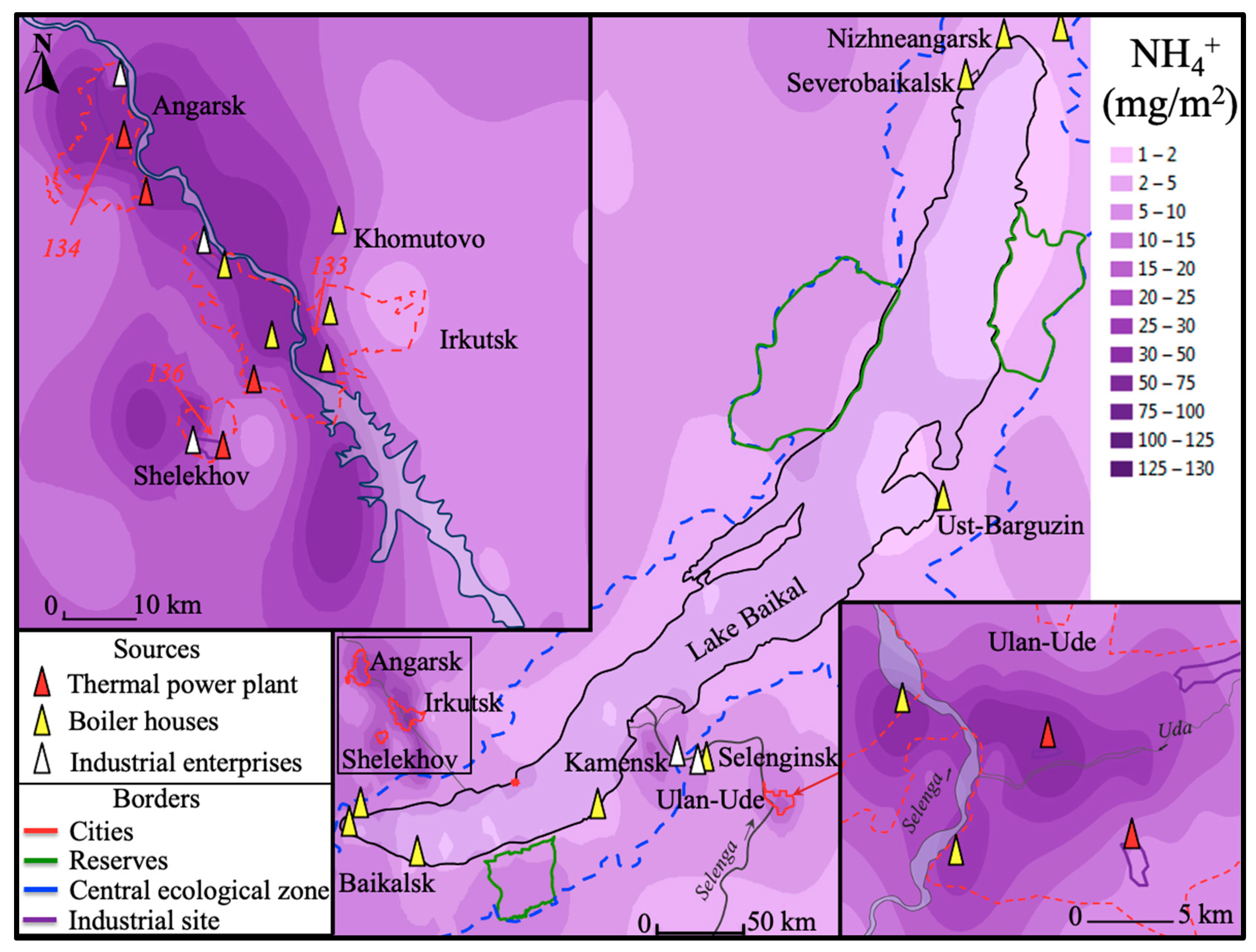
| Districts | Acreage, km2 Number of Receptor Points | Quantity of Atmospheric Precipitation, mm/Year, Snow Height, cm | Soils | Vegetation | Anthropogenic Sources |
|---|---|---|---|---|---|
| Irkutsk | 305 37 | 485 22 | Gray, dark gray, alluvial gray-humus, sod-podzolic | Larch-pine forests, young birch and aspen forests, shrub communities, meadow communities | Mechanical engineering and instrumentation, heat and power engineering, electric power industry, production of building materials, light and food industry, automobile, and railway transport |
| Angarsk | 294 22 | 480 20 | Sod-calcareous, sod-podzolic, gray forest, sod-gray | Pine forests, young birch and aspen forests, shrub communities, meadow communities | Chemical and petrochemical industry, thermal power engineering, production of building materials, light and food industry, automobile and railway transport |
| Shelekhov | 31 24 | 485 22 | Gray forest gleyic and gley, soddy-podzolic | Larch-pine forests, young birch and aspen forests, shrub communities, meadow communities | The main industries are non-ferrous metallurgy, thermal power engineering, motor transport |
| Ulan-Ude | 347 28 | 280 18 | Soddy-forest and sandy loamy soils, alluvial meadow marsh and meadow-marsh soils | Tree and shrub vegetation, meadow and steppe communities | The main industries are mechanical engineering and metalworking, thermal power engineering, automobile and railway transport |
| Selenginsk and Kamensk | 20 20 | 440–460 35 | Soddy forest gray | Tree and shrub vegetation, wet meadows, meadow and steppe communities | The main industries are woodworking, pulp and paper, construction, municipal energy, road transport |
| Irkutsk—Listvyanka | 260 14 | 485–490 30 | Gray, soddy-podzolic, podzolized podburs | Larch-pine forests, birch forests, shrub communities | Municipal boiler houses, house stoves, road transport |
| Irkutsk—Bolshoe Goloustnoye | 212 15 | 485–240 27 | Gray, soddy-podzolic, podzolized podburs | Larch-pine forests, steppes | Woodworking enterprises, communal boiler houses, house stoves, road transport |
| Delta of the Selenga River | 540 26 | 440 11 | Alluvial gray-humus meadow bog, alluvial meadow carbonate, alluvial soddy | Grass swamps, wet meadows, pine forests | Municipal boiler houses, house stoves, road transport |
| Ulan-Ude Kurumkan | 5670 31 | 280–380 26 | Podburs, coarse humus burozems, alluvial gray humus, gray and light humus | Cedar-larch-pine forests, swamps | Municipal boilers, house stoves, road transport, agriculture |
| Southeastern shore | 796 24 | 640 50 | Podzolized podburs | Fir-spruce-cedar forest, birch forests | Production of building materials, municipal boiler houses, house stoves, road and railway transport |
| Baikal National Nature Reserve | 1657 8 | 1360 98 | Permafrost-taiga, soddy-lithogenic brown forest coarse humus burozems | Fir-spruce-cedar forests, alpine meadows, shrub communities | No anthropogenic sources are available |
| The coast of the southern basin of Baikal | 7200 49 | 430 12 | Podzolized podburs, coarse burozems, cryozems | Larch-pine forests, birch forests, swamp vegetation, fir-spruce-cedar forests | Municipal boiler houses, production of building materials, house stoves, road and railway transport |
| Coast of the middle basin of Baikal | 11,600 64 | 350 12 | Podburs, coarse humus, chestnut, soddy-podbrown burozems | Pine forests, larch forests, cedar-larch-pine forests, steppe vegetation, swamp vegetation | Municipal boiler houses, house stoves, road transport |
| The coast of the northern basin of Baikal | 12,700 53 | 330 11 | Podburs, podzols, cryozems, eutrophic peat soils, dark-humus carbon-lithozems | Cedar-larch-pine forests, dwarf pine, larch forests, birch forests, marsh vegetation | Municipal boiler houses, house stoves, railway and road transport |
Disclaimer/Publisher’s Note: The statements, opinions and data contained in all publications are solely those of the individual author(s) and contributor(s) and not of MDPI and/or the editor(s). MDPI and/or the editor(s) disclaim responsibility for any injury to people or property resulting from any ideas, methods, instructions or products referred to in the content. |
© 2023 by the authors. Licensee MDPI, Basel, Switzerland. This article is an open access article distributed under the terms and conditions of the Creative Commons Attribution (CC BY) license (https://creativecommons.org/licenses/by/4.0/).
Share and Cite
Molozhnikova, Y.V.; Shikhovtsev, M.Y.; Netsvetaeva, O.G.; Khodzher, T.V. Ecological Zoning of the Baikal Basin Based on the Results of Chemical Analysis of the Composition of Atmospheric Precipitation Accumulated in the Snow Cover. Appl. Sci. 2023, 13, 8171. https://doi.org/10.3390/app13148171
Molozhnikova YV, Shikhovtsev MY, Netsvetaeva OG, Khodzher TV. Ecological Zoning of the Baikal Basin Based on the Results of Chemical Analysis of the Composition of Atmospheric Precipitation Accumulated in the Snow Cover. Applied Sciences. 2023; 13(14):8171. https://doi.org/10.3390/app13148171
Chicago/Turabian StyleMolozhnikova, Yelena V., Maxim Yu. Shikhovtsev, Olga G. Netsvetaeva, and Tamara V. Khodzher. 2023. "Ecological Zoning of the Baikal Basin Based on the Results of Chemical Analysis of the Composition of Atmospheric Precipitation Accumulated in the Snow Cover" Applied Sciences 13, no. 14: 8171. https://doi.org/10.3390/app13148171
APA StyleMolozhnikova, Y. V., Shikhovtsev, M. Y., Netsvetaeva, O. G., & Khodzher, T. V. (2023). Ecological Zoning of the Baikal Basin Based on the Results of Chemical Analysis of the Composition of Atmospheric Precipitation Accumulated in the Snow Cover. Applied Sciences, 13(14), 8171. https://doi.org/10.3390/app13148171







